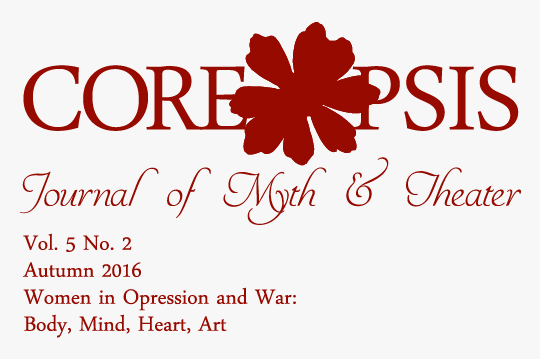Art and Social Action
Art and Social Action: The Work of Chip Thomas, The Society for Ritual Arts 2016 Artist in Residence
by Helena Domenic
As an artist and curator, I enjoy being able to view the work of other artists and hearing about their process. I had the distinct pleasure of interviewing Chip Thomas, currently the Artist in Residence for the Society for Ritual Arts. Chip’s CV alone is amazing; he is a photographer, doctor, community artist and activist, whose large (wall-sized) photographs adorn roadside structures throughout Navajo country. He is also a member of the Justseeds Artists Cooperative, a collective of 30 international artists whose work reflects a socially engaged aesthetic. I wanted to learn from where Chip drew his inspiration, and more about the collaborative nature of community-based artwork.
 CMJT: Your work is really amazing – I have been looking at the large murals you created throughout the Navajo nation, and I see that you belong to an artist’s collective of socially engaged artists. Obviously, there is a connection there. What was the inspiration behind creating the murals within the Navajo Nation?
CMJT: Your work is really amazing – I have been looking at the large murals you created throughout the Navajo nation, and I see that you belong to an artist’s collective of socially engaged artists. Obviously, there is a connection there. What was the inspiration behind creating the murals within the Navajo Nation?
Thomas: Thanks for that feedback. I was a child of the 60s who looked forward each week to the black + white photo essays found in Life, Look and occasionally Ebony magazines by notable photographers such as Eugene Smith and Gordon Parks and others. Their stories of the lives of everyday people moved me to attempt being a visual story teller. I started working as a primary care physician on the Navajo nation in 1987 and was moved by disparities in material wealth and health despite the abundance of natural resources + generations of traditional knowledge here. Psychologists and social scientists speak of the “soul wound” or the psychological and spiritual sense of defeat + hopelessness that is passed from generation to generation in historically oppressed groups. With my murals I wanted to create a dialogue with the community where I reflect back to them some of the beauty I’ve had a chance to experience during my 29 years of working here.
CMJT: Can you tell me a little more about Justseeds?
Thomas: Justseeds is an artist cooperative, a small group of printmakers, poets, activists and anarchists whose work focuses on social justice, antiwar and environmental issues. They saw my work celebrating every person on the Navajo nation as being representative of their values and invited me to join them. I was honored to do so.
CMJT: You’ve been working with the Navajo a long time. How did you come into contact with this community? How have they responded to the Painted Desert project?
Thomas: The government paid for my medical school education through the National Health Service Corps. Having a four year obligation to work in a health shortage area I chose to work here and fell in love with the land and the culture of the Navajo in the high altitude desert of the Colorado Plateau. Appreciating the ongoing need for health care and continuity of care in my isolated community on the Navajo nation I chose not to leave after my obligated period.
CMJT: That is really great. I have known a few artists involved in similar projects who chose to remain in the communities they were assisting once their commitment ended.
Thomas: I started my mural project in 2009 after a 3 month sabbatical in Brazil where I had an opportunity to spend time with people doing street art. There’s not a tradition of street art on the reservation and there are cultural issues with the use photography that date back to the early 1900s. In this sense I was introducing a new art form to my corner of the Navajo nation. (I say this because the reservation is 27,000 square miles in size and is home to just under 200,000 people. My art project has a 200 mile radius in the western part of the Navajo nation.) Initially there was skepticism especially amongst older, more traditional people. I created murals that I thought would speak to them by using imagery of sheep. Over time there’s been greater acceptance of the imagery and people see the murals as an effort to celebrate the culture.
CMJT: How did the Painted Desert Project come into being, and how do you find artists to collaborate? Are there any particular qualities you are looking for in the artists who participate in the project?
Thomas: As I mentioned, I started my photography-based mural project in 2009. By 2012, I’d learned that roadside vendors who sell jewelry to tourists get more tourists stopping at their stands if they have interesting art on those stands. In 2012, I invited a group of street artists who have a strong social practice component to their work to come out to the reservation, spend some time interacting with people here and then paint murals. This was the inception of the Painted Desert Project. I’m happy to say the emphasis is shifting away from solely creating art to helping materially by repairing or rebuilding roadside stands and then creating murals on those structures. The emphasis of the project is becoming more community service-oriented.
CMJT: Thank you so much for taking the time to talk with me about your work. I find more and more artists are responding to the current news cycle by producing culturally sensitive work. Thank you for your efforts!
Chips’s work can be viewed on his website at: http://www.chipthomasphotography.com and on the Society for Ritual Arts page: http://www.societyforritualarts.org/coreopsis/spring-2016-issue/from-the-old-king-to-the-new-king/.
All images are by Chip Thomas, 2016, all rights reserved.

 Next Post
Next Post
[…] Interview with Chip Thomas […]